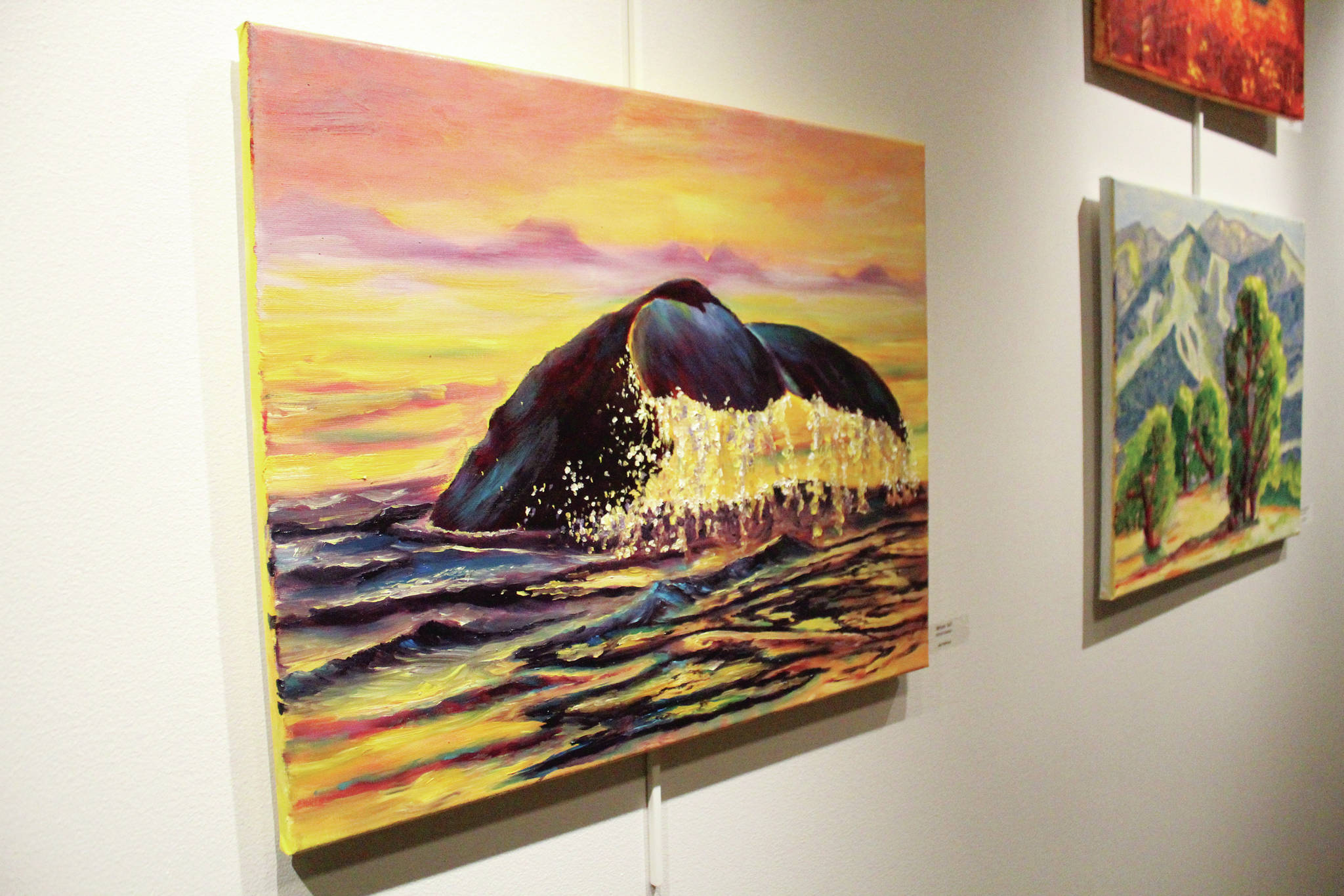In traditional college classes, students might quietly slip an assignment onto their professor’s desk — or, in the modern age, email it. In artist Asia Freeman’s painting class at Kachemak Bay Campus, “quiet” doesn’t apply.
Last Friday during one of several First Friday exhibit openings in town, Freeman’s students showed their work at a reception for a collection of their work in Pioneer Hall at Homer’s branch campus of Kenai Peninsula College. Painted in bright, dynamic colors that glow with light, their creations illustrate a technique Freeman teaches that dates back to the Old Masters, artists working around 1200 to 1830.
An art teacher at KBC for 20 years, Freeman teaches beginning and intermediate drawing as well as painting. An an artist herself and artistic director at Bunnell Street Arts Center, Freeman said her teaching style has evolved based on workshops she’s taken, people she’s taught and artists she has met at Bunnell.
“I’ve really felt like the most exciting thing about living here and I’ve been able to enjoy through workshops is color, color theory,” she said.
In her class, she applies that by using the Old Masters method of starting with earth tones on a canvas rather than a blank white surface. The students lay down colors like raw umber and burnt sienna. They then use the rub out technique of wiping away light areas and building up darker areas to make a value study — that is, arrangements of light and dark.
“That has three functions,” Freeman said. “It organizes composition and arranges values in spaces and helps set up a successful painting and also determine a light source, where it’s moving through the composition.”
Student artist David Sorensen talked about how that works in his painting, “Angels with Dirty Faces,” a painting of an Alaska trailer park inspired by a blog post by artist Michael Hankins. Hankins wrote about living in an Alaska trailer park and how as a kid that was blissful to him despite the negative stigma of trailer parks. Sorensen’s painting gets its title from a song by the 1970s British punk band, Sham 69.
“Their whole spiel was working class uprising and unity,” he said of the band. “They felt that punk rock had become too pretentious and elitist. The people who needed a punk attitude in society were the working class.”
In his painting, Sorensen started with burnt umber and Alizarin crimson as his underpainting.
“After the underpainting dried, I wiped out a few colors on the trailers until I got a really metalic look on them,” he said. “That was mostly from using a little bit of white and a little bit of green.”
Sorensen said Freeman taught them to think about color not as “oh, this thing is this color.”
“I’m trying to give this thing a certain value, and this color aligns with this value so it makes sense to use this color,” he said. “… You’re thinking of a continuum of value based on the colors you have on the canvas and what makes sense relatively.”
Another student artist, Lyn Maslow, a retired school teacher, elaborated on the technique.
“You have a kind of underlying color,” she said. “You look at a scene and decide to go with a pinkish background or a yellow background. You start to build on that. It works really well. You take out one step by starting with a basic color.”
Freeman’s students don’t stop with the Old Masters technique of laying colors down.
“Ironically, we start out in this sober, Old Masters fashion with these earth tones,” she said. “As people get a sense of how they can use a monochromatic palette, I transition them right away into a complementary approach.”
Though she took two of Freeman’s drawing classes, Maslow said Freeman’s was her first class in painting.
“It’s all new,” she said. “… I had no clue how to use color whatsoever. I didn’t know what complementary colors were.”
Complementary colors are colors that are opposite each other on a color wheel. For example, purple is a complementary color to yellow. A student might paint a whole canvas yellow, Freeman said.
“Instead of light brown, they put purple on bright yellow,” she said. “Suddenly the yellow reads more as light and the purple reads more as shadows, but they’re luminous shadows.”
Freeman said that leads to a joyful discovery, where students find the excitement is not in being literal, but in working at opposites on the color wheel.
Sorensen had more experience as an artist, having taken classes in high school and college. One thing Freeman helped hone in to him was using broader brush strokes and not focusing so much on detail.
“She challenged me to use bigger brushes and make bolder decisions,” he said.
Freeman encouraged them to loosen up, Maslow said.
“That’s the fun part of painting,” she said. “You’re not tied to that kind of precise detail. … I think she’s trying to make us explore a little more.”
“That’s my approach,” Freeman said of her teaching style. “It leads to some very fun, exciting paintings.”
Maslow said she found the mix of students from ages teen to retired part of the appeal of the class. She mentioned Drew Wimmerstedt, one of the younger students, and Linda Franklin, closer to Maslow’s age.
“Drew is so supportive because she’s very, very thoughtful,” she said. “She’s (Franklin) having fun loosening up with color. Asia is so good at facilitating these discussions, our processes, what we want to do next. It’s ideal to grow as a painter.”
The students also ranged in experience. Two students, Jennifer DePesa and Britni Siekaniec, have had solo shows in Homer.
“It’s been a real positive experience,” Maslow said. “… It’s been kind of fun to have the time and be with a group of people who love painting.”
Reach Michael Armstrong at marmstrong@homernews.com.


